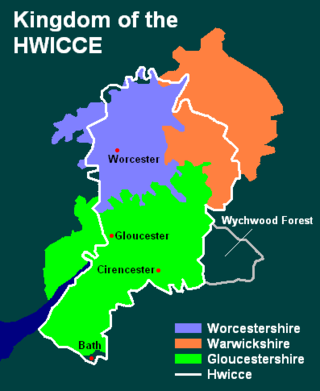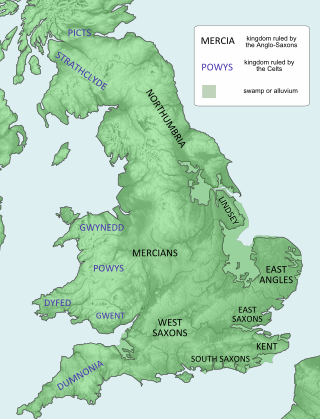Related Research Articles

Offa was King of Mercia, a kingdom of Anglo-Saxon England, from 757 until his death. The son of Thingfrith and a descendant of Eowa, Offa came to the throne after a period of civil war following the assassination of Æthelbald. Offa defeated the other claimant, Beornred. In the early years of Offa's reign, it is likely that he consolidated his control of Midland peoples such as the Hwicce and the Magonsæte. Taking advantage of instability in the kingdom of Kent to establish himself as overlord, Offa also controlled Sussex by 771, though his authority did not remain unchallenged in either territory. In the 780s he extended Mercian Supremacy over most of southern England, allying with Beorhtric of Wessex, who married Offa's daughter Eadburh, and regained complete control of the southeast. He also became the overlord of East Anglia and had King Æthelberht II of East Anglia beheaded in 794, perhaps for rebelling against him.

Ecgberht, also spelled Egbert, Ecgbert, Ecgbriht, Ecgbeorht, and Ecbert, was King of Wessex from 802 until his death in 839. His father was King Ealhmund of Kent. In the 780s, Ecgberht was forced into exile to Charlemagne's court in the Frankish Empire by the kings Offa of Mercia and Beorhtric of Wessex, but on Beorhtric's death in 802, Ecgberht returned and took the throne.

Æthelbald was the King of Mercia, in what is now the English Midlands from 716 until he was killed in 757. Æthelbald was the son of Alweo and thus a grandson of King Eowa. Æthelbald came to the throne after the death of his cousin, King Ceolred, who had driven him into exile. During his long reign, Mercia became the dominant kingdom of the Anglo-Saxons, and recovered the position of pre-eminence it had enjoyed during the strong reigns of Mercian kings Penda and Wulfhere between about 628 and 675.

Æthelred was king of Mercia from 675 until 704. He was the son of Penda of Mercia and came to the throne in 675, when his brother, Wulfhere of Mercia, died from an illness. Within a year of his accession he invaded Kent, where his armies destroyed the city of Rochester. In 679 he defeated his brother-in-law, Ecgfrith of Northumbria, at the Battle of the Trent: the battle was a major setback for the Northumbrians, and effectively ended their military involvement in English affairs south of the Humber. It also permanently returned the kingdom of Lindsey to Mercia's possession. However, Æthelred was unable to re-establish his predecessors' domination of southern Britain.

Wulfhere or Wulfar was King of Mercia from 658 until 675 AD. He was the first Christian king of all of Mercia, though it is not known when or how he converted from Anglo-Saxon paganism. His accession marked the end of Oswiu of Northumbria's overlordship of southern England, and Wulfhere extended his influence over much of that region. His campaigns against the West Saxons led to Mercian control of much of the Thames valley. He conquered the Isle of Wight and the Meon valley and gave them to King Æthelwealh of the South Saxons. He also had influence in Surrey, Essex, and Kent. He married Eormenhild, the daughter of King Eorcenberht of Kent.

Coenwulf was the King of Mercia from December 796 until his death in 821. He was a descendant of King Pybba, who ruled Mercia in the early 7th century. He succeeded Ecgfrith, the son of Offa; Ecgfrith only reigned for five months, and Coenwulf ascended the throne in the same year that Offa died. In the early years of Coenwulf's reign he had to deal with a revolt in Kent, which had been under Offa's control. Eadberht Præn returned from exile in Francia to claim the Kentish throne, and Coenwulf was forced to wait for papal support before he could intervene. When Pope Leo III agreed to anathematise Eadberht, Coenwulf invaded and retook the kingdom; Eadberht was taken prisoner, was blinded, and had his hands cut off. Coenwulf also appears to have lost control of the kingdom of East Anglia during the early part of his reign, as an independent coinage appears under King Eadwald. Coenwulf's coinage reappears in 805, indicating that the kingdom was again under Mercian control. Several campaigns of Coenwulf's against the Welsh are recorded, but only one conflict with Northumbria, in 801, though it is likely that Coenwulf continued to support the opponents of the Northumbrian king Eardwulf.

Hwicce was a tribal kingdom in Anglo-Saxon England. According to the Anglo-Saxon Chronicle, the kingdom was established in 577, after the Battle of Deorham. After 628, the kingdom became a client or sub-kingdom of Mercia as a result of the Battle of Cirencester.

Coenred was king of Mercia from 704 to 709. Mercia was an Anglo-Saxon kingdom in the English Midlands. He was a son of the Mercian king Wulfhere, whose brother Æthelred succeeded to the throne in 675 on Wulfhere's death. In 704, Æthelred abdicated in favour of Coenred to become a monk.

Ceolred was King of Mercia from 709 to 716.

Wiglaf was King of Mercia from 827 to 829 and again from 830 until his death. His ancestry is uncertain: the 820s were a period of dynastic conflict within Mercia and the genealogy of several of the kings of this time is unknown. Wigstan, his grandson, was later recorded as a descendant of Penda of Mercia, so it is possible that Wiglaf was descended from Penda, one of the most powerful seventh-century kings of Mercia.
Wihtred was king of Kent from about 690 or 691 until his death. He was a son of Ecgberht I and a brother of Eadric. Wihtred ascended to the throne after a confused period in the 680s, which included a brief conquest of Kent by Cædwalla of Wessex, and subsequent dynastic conflicts. His immediate predecessor was Oswine, who was probably descended from Eadbald, though not through the same line as Wihtred. Shortly after the start of his reign, Wihtred issued a code of laws—the Law of Wihtred—that has been preserved in a manuscript known as the Textus Roffensis. The laws pay a great deal of attention to the rights of the Church, including punishment for irregular marriages and for pagan worship. Wihtred's long reign had few incidents recorded in the annals of the day. He was succeeded in 725 by his sons, Æthelberht II, Eadberht I, and Alric.
Beorhtwulf was King of Mercia, a kingdom of Anglo-Saxon England, from 839 or 840 to 852. His ancestry is unknown, though he may have been connected to Beornwulf, who ruled Mercia in the 820s. Almost no coins were issued by Beorhtwulf's predecessor, Wiglaf, but a Mercian coinage was restarted by Beorhtwulf early in his reign, initially with strong similarities to the coins of Æthelwulf of Wessex, and later with independent designs. The Vikings attacked within a year or two of Beorhtwulf's accession: the province of Lindsey was raided in 841, and London, a key centre of Mercian commerce, was attacked the following year. Another Viking assault on London in 851 "put Beorhtwulf to flight", according to the Anglo-Saxon Chronicle; the Vikings were subsequently defeated by Æthelwulf. This raid may have had a significant economic impact on Mercia, as London coinage is much reduced after 851.
Ceolwulf II was the last king of independent Mercia. He succeeded Burgred of Mercia who was deposed by the Vikings in 874. His reign is generally dated 874 to 879 based on a Mercian regnal list which gives him a reign of five years. However, D. P. Kirby argues that he probably reigned into the early 880s. By 883, he was replaced by Æthelred, Lord of the Mercians, who became ruler of Mercia with the support of Alfred the Great, king of Wessex.

The Tribal Hidage is a list of thirty-five tribes that was compiled in Anglo-Saxon England some time between the 7th and 9th centuries. It includes a number of independent kingdoms and other smaller territories, and assigns a number of hides to each one. The list is headed by Mercia and consists almost exclusively of peoples who lived south of the Humber estuary and territories that surrounded the Mercian kingdom, some of which have never been satisfactorily identified by scholars. The value of 100,000 hides for Wessex is by far the largest: it has been suggested that this was a deliberate exaggeration.
Eardwulf was king of Northumbria from 796 to 806, when he was deposed and went into exile. He may have had a second reign from 808 until perhaps 811 or 830. Northumbria in the last years of the eighth century was the scene of dynastic strife between several noble families: in 790, king Æthelred I attempted to have Eardwulf assassinated. Eardwulf's survival may have been viewed as a sign of divine favour. A group of nobles conspired to assassinate Æthelred in April 796 and he was succeeded by Osbald: Osbald's reign lasted only twenty-seven days before he was deposed and Eardwulf became king on 14 May 796.
The Haestingas, or Heastingas or Hæstingas, were one of the tribes of Anglo-Saxon Britain. Not very much is known about them. They settled in what became East Sussex sometime before the end of the 8th century. A 12th-century source suggested that they were conquered by Offa of Mercia, in 771. They were also recorded in the Anglo-Saxon Chronicle (ASC) as being an autonomous grouping as late as the 11th century.

The Kingdom of the East Angles, today known as the Kingdom of East Anglia, was a small independent kingdom of the Angles comprising what are now the English counties of Norfolk and Suffolk and perhaps the eastern part of the Fens. The kingdom formed in the 6th century in the wake of the Anglo-Saxon settlement of Britain. It was ruled by the Wuffingas dynasty in the 7th and 8th centuries, but fell to Mercia in 794, and was conquered by the Danes in 869, to form part of the Danelaw. It was conquered by Edward the Elder and incorporated into the Kingdom of England in 918.
The Stoppingas was a tribe or clan of Anglo-Saxon England. Their domain was Wootton Wawen and the valley of the River Alne in modern-day Warwickshire. The name of the tribe may have come from the personal name Stoppa, who could have been the tribe's founder or leader, or earliest common ancestor.
The Beormingas were a tribe or clan in Anglo-Saxon England, whose territory possibly formed a regio or early administrative subdivision of the Kingdom of Mercia. The name literally means "Beorma's people" in Old English, and Beorma is likely to have been either the leader of the group during its settlement in Britain or a real or legendary tribal ancestor. The name of the tribe is recorded in the place name Birmingham, which means "home of the Beormingas".
The Pencersæte were a tribe or clan in Anglo-Saxon England. They lived in the valley of the River Penk in the West Midlands, and remained around Penkridge throughout the existence of the Kingdom of Mercia.
References
- 1 2 "Willenhall History". www.historywebsite.co.uk. Retrieved 19 March 2019.
- ↑ Appleby Magna History Archived 2009-09-11 at the Wayback Machine
- ↑ "A historical timeline of Wirksworth" Archived 2012-02-19 at the Wayback Machine
- ↑ Hooke, Della; Sawyer, P. H. (1990). "Ninth-century lease with boundary clause". Worcestershire Anglo-Saxon charter bounds. Boydell & Brewer. pp. 135–142. ISBN 0-85115-276-7 . Retrieved 13 April 2009.
- ↑ "Humberht 1". Prosopography of Anglo-Saxon England . Retrieved 13 April 2009.
- 1 2 Kirby, D. P. (2000). "The Tribal Hidage". The Earliest English Kings. Routledge. p. 10. ISBN 0-415-24211-8 . Retrieved 19 April 2009.
- ↑ Rotherham, Ian (9 May 2013). Cultural Severance and the Environment: The Ending of Traditional and Customary Practice on Commons and Landscapes Managed in Common. Springer Science & Business Media. ISBN 9789400761599.